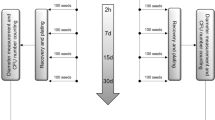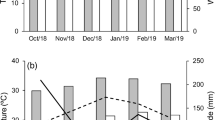Abstract
Commercial liquid inoculants for soybean, stored at 20 °C for 1–8 years in 400 ml bottles or in 5000 ml containers, were assessed for their efficacy and changes in the physiological activity of Bradyrhizobium japonicum. A decrease in viable counts and in bacterial survival on seeds was observed in inoculants stored for several years. The number of nodules produced per plant in a growth chamber decreased and was correlated to the number of bacteria surviving on the seeds. Changes in physiological properties were assessed using biochemical, physiological and microscopic methods. The cell total sugars content decreased with increased storage of the inoculants. High calculated ratios of suspended solid dry matter/carbon/nitrogen/proteins weight per c.f.u. strongly suggested the presence of dead or viable but non-culturable (VBNC) cells in the inoculants. This was confirmed in a study of bacterial respiratory activity, using p-iodonitrotetrazolium reduction. The time of colony appearance on plates increased in the old inoculants stored for a long time, especially on yeast-free culture medium. The heterogeneity in colony size also increased with storage length. Inoculants stored for more than 2 years could be differentiated from the others by using nalidixic acid against cellular division. Nucleic acid staining of cells showed that the percentage of membrane-compromised bacteria in all the inoculants increased with increased storage length, whatever the type of packaging used for the inoculants. These results demonstrated that the physiological activity of B. japonicum cells in commercial liquid inoculants changes after storage. To complete c.f.u. determination, three methods were proposed to assess the fitness of stored bradyrhizobia, but they remain to be checked for reliability on a variety of commercial inoculants.
Similar content being viewed by others
References
Aiba, S., Humphrey, A.E. & Millis, N.F. 1973 Biochemical Engineering. New York and London: Academic Press Inc., 434 pp.
Bakken, L.R. & Olsen, R.A. 1989 DNA-content of soil bacteria of different cell size. Soil Biology and Biochemistry 21, 789–793.
Bergersen, F.J. 1961 The growth of Rhizobium in synthetic media. Australian Journal of Biological Sciences 14, 349–360.
Boylen, C.W. & Mulks, M.H. 1978 The survival of coryneform bacteria during periods of prolonged nutrient starvation. Journal of General Microbiology 105, 323–334.
Catroux, G. 1991 Inoculant quality standards and controls in France. In Expert Consultation on Legume Inoculant Production and Quality Control, ed. Thompson, V.A. pp. 117–124. 19–21 March 1991, Roma, FAO.
Catroux, G., Hartmann, A. & Revellin, C. 2001 Trends in rhizobial inoculant production and use. Plant and Soil 230, 21–30.
Cliquet, S., Durier, C. & Catroux, G. 1992 Use of central composite experimental design for the development of Bradyrhizobium japonicum liquid inoculants. Biotechnology Techniques 6, 477–482.
Crist, D.K., Wyza, R.E., Mills, K.K., Bauer, W.D. & Evans, W.R. 1984 Preservation of Rhizobium viability and symbiotic infectivity by suspension in water. Applied and Environmental Microbiology 47, 895–900.
Ellis, R.J., Thompson, I.P. & Bailey, M.J. 1995 Metabolic profiling as a means of characterizing plant-associated microbial communities. FEMS Microbiology Ecology 16, 9–18.
Fehr, W.R., Caviness, C.E., Burmood, D.T. & Pennington, J.S. 1971 Stage of development descriptions for soybean Glycine max L. Merril. Crop Science 71, 929–931.
Gibson, A.H., Demaz, D.H., Gault, R.R., Bhuvaneswari, T.V. & Brockwell, J. 1991 Genetic stability in Rhizobia in the field. In The Rhizosphere and Plant Growth, eds. Keiser, D.L. & Cregan, P.B. pp. 141–148. The Netherlands: Kluwer Academic Publishers.
Givskov, M., Eberl, L., Moller, S., Poulsen, L.K. & Molin, S. 1994 Responses to nutrient starvation in Pseudomonas putida KT2442: analysis of general cross-protection, cell shape, and macromolecular content. Journal of Bacteriology 176, 7–14.
Griffith, G.W., Roughley, R.J. & Brown, J.F. 1992 The effect of packaging films on growth and survival of Rhizobia in peat culture. Letters in Applied Microbiology 14, 241–243.
Herbert, D., Phipps, P.J. & Strange, R.E. 1971 Carbohydrate analysis: determination of ‘total carbohydrate’. In Methods in Microbiology, vol 5b, eds. Norris, J.R. & Ribbons, D.W. pp. 266–273. London and New York: Academic Press.
Hiltbold, A.E., Thurlow, D.L. & Skipper, H.D. 1980 Evaluation of commercial soybean inoculants by various techniques. Agronomy Journal 72, 675–681.
Hume, D.J. & Blair, D.H. 1992 Effect of numbers of Bradyrhizobium japonicum applied in commercial inoculants on soybean seed yield in Ontario. Canadian Journal of Microbiology 38, 588–593.
Hungria, M. & Vargas, M.A.T. 2000 Environmental factors affecting N2 fixation in grain legumes in the tropics, with an emphasis on Brazil. Field Crops Research 65, 151–164.
Iacobellis, N.S. & Devay, J.E. 1986 Long-term storage of plant-pathogenic bacteria in sterile distilled water. Applied and Environmental Microbiology 52, 388–389.
Jorgensen, F., Nybroe, O. & Knochel, S. 1994 Effects of starvation and osmotic stress on viability and heat resistance of Pseudomonas fluorescens AH9. Journal of Applied Bacteriology 77, 340–347.
Kennedy, A.C. & Wollum, A.C.I. 1988 Enumeration of Bradyrhizobium japonicum in soil subjected to high temperature: comparison of plate count, most probable number and fluorescent antibody techniques. Soil Biology and Biochemistry 20, 933–937.
Kogure, K., Simidu, U. & Taga, N. 1979 A tentative direct microscopic method for counting living marine bacteria. Canadian Journal of Microbiology 25, 415–420.
Kremer, R.J. & Peterson, H.L. 1983 Effects of carrier and temperature on survival of Rhizobium spp. in legume inocula: development of an improved type of inoculant. Applied and Environmental Microbiology 45, 1790–1794.
Lagacherie, B. 1978 Survie dans le sol des Rhizobium apportés par inoculation des graines de soja. Informations techniques CETIOM 62, 11–15.
Lupwayi, N.Z., Olsen, P.E., Sande, E.S., Keyser, H.H., Collins, M.M., Singleton, P.W. & Rice, W.A. 2000 Inoculant quality and its evaluation. Field Crops Research 65, 259–270.
Morita, R.Y. 1992 Low-nutrient environments. In Encyclopedia of Microbiology, vol 2, eds. Lederberg, J., Alexander, M. & Hopwood, D.A. pp. 617–624. New York and London: Academic Press, Inc.
Moyer, C.L. & Morita R.Y. 1989 Effect of growth rate and starvation-survival on the viability and stability of a psychrophilic marine bacterium. Applied and Environmental Microbiology 55, 1122–1127.
Novitsky, J.A. & Morita, R.Y. 1977 Survival of a psychrophilic marine Vibrio under long-term nutrient starvation. Applied and Environmental Microbiology 33, 635–641.
Obaton, M. & Rollier, M. 1970 L'inoculation du soja: influence de la qualité de l'inoculum sur le rendement en grain et la richesse en protéine de la récolte. Compte-Rendu de l'Académie d'Agriculture Française, 1174–1189.
Olsen, P.E. & Rice, W.A. 1996 Rapid evaluation of peat-base legume inoculant using immunomagnetic beads for cell retrieval and fluorescent nucleic acid probes for viability analysis. Plant and Soil 186, 75–79.
Pinochet, X., Arnaud, F. & Cleyet-Marel, J.C. 1993 Competition for nodule occupancy of introduced Bradyrhizobium japonicum strain SMGS1 in French soils already containing Bradyrhizobium japonicum strain G49. Canadian Journal of Microbiology 39, 1022–1028.
Revellin, C., Pinochet, X., Beauclair, P. & Catroux, G. 1996 Influence of soil properties and soya bean cropping history on the Bradyrhizobium japonicum population in some French soils. European Journal of Soil Science 47, 505–510.
Revellin, C., Meunier, G., Giraud, J.-J., Sommer, G., Wadoux, P. & Catroux, C. 2000 Changes in the physiological and agricultural characteristics of peat-based Bradyrhizobium japonicum inoculants after long-term storage. Applied Microbiology and Biotechnology 54, 206–211.
Rodriguez, G.G., Phipps, D., Ishiguro, K. & Ridgway, H.F. 1992 Use of a fluorescent redox probe for direct visualization of actively respiring bacteria. Applied and Environmental Microbiology 58, 1801–1808.
Roughley, R.J., Simanungkalit, R.D.M., Gemell, L.G., Hartley, E.J. & Cain, P. 1995 Growth and survival of root-nodule bacteria in legume inoculants stored at high temperatures. Soil Biology and Biochemistry 27, 707–712.
Trevors, J.T. 1984 Dehydrogenase activity in soil: a comparison between the INT and TTC assay. Soil Biology and Biochemistry 16, 673–674.
Wadoux, P. 1991 Inoculant production in industry using sterile carriers. In Expert Consultation on Legume Inoculant Production and Quality Control, ed. Thompson, V.A. pp. 33–42. 19–21 March 1991, Roma, FAO.
Wagner, S.C. & Skipper, H.D. 1993 Long-term storage of Bradyrhizobia in sterile water. Canadian Journal of Microbiology 39, 998–1001.
Wilson, D.O. & Trang, K.M. 1980 Effects of storage temperature and enumeration method on Rhizobium spp. numbers in peat inoculants. Tropical Agriculture 57, 233–238.
Zimmerman, R., Iturriaga, R. & Becker-Birck, J. 1978 Simultaneous determination of the total number of aquatic bacteria and the number thereof involved in respiration. Applied and Environmental Microbiology 36, 926–935.
Author information
Authors and Affiliations
Rights and permissions
About this article
Cite this article
Maurice, S., Beauclair, P., Giraud, JJ. et al. Survival and change in physiological state of Bradyrhizobium japonicum in soybean (Glycine max L. Merril) liquid inoculants after long-term storage. World Journal of Microbiology and Biotechnology 17, 635–643 (2001). https://doi.org/10.1023/A:1012424618554
Issue Date:
DOI: https://doi.org/10.1023/A:1012424618554




